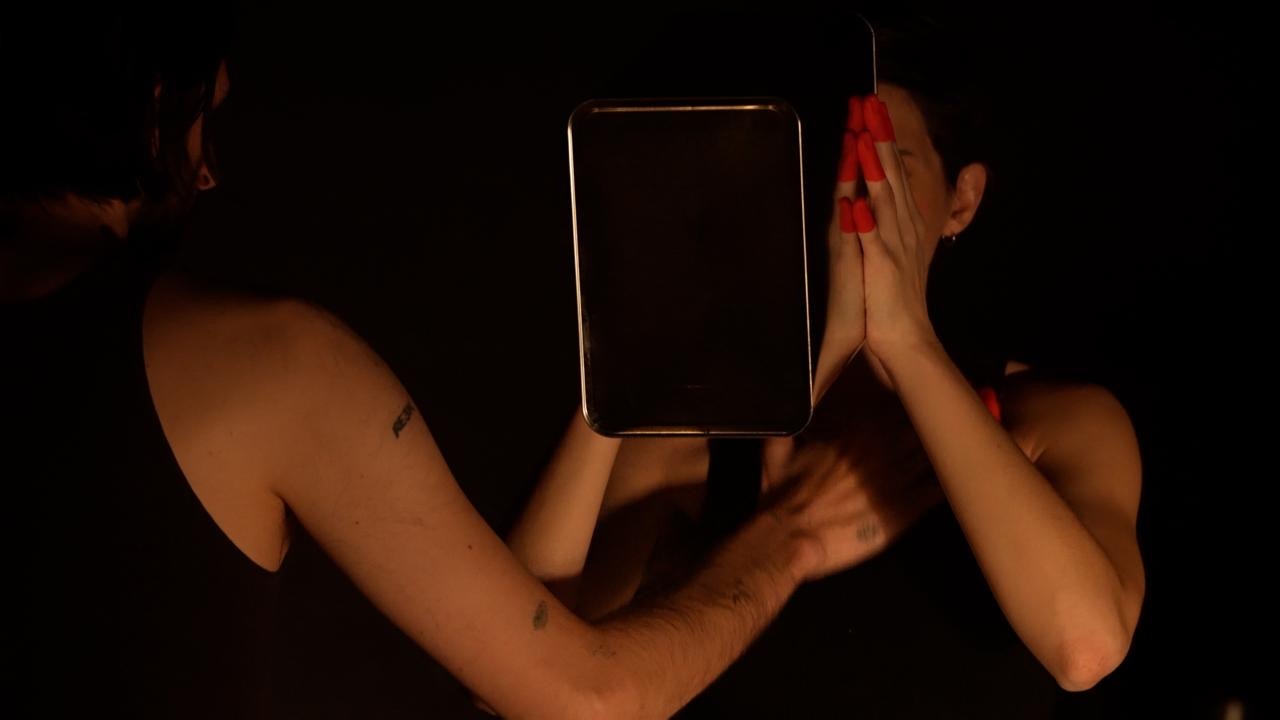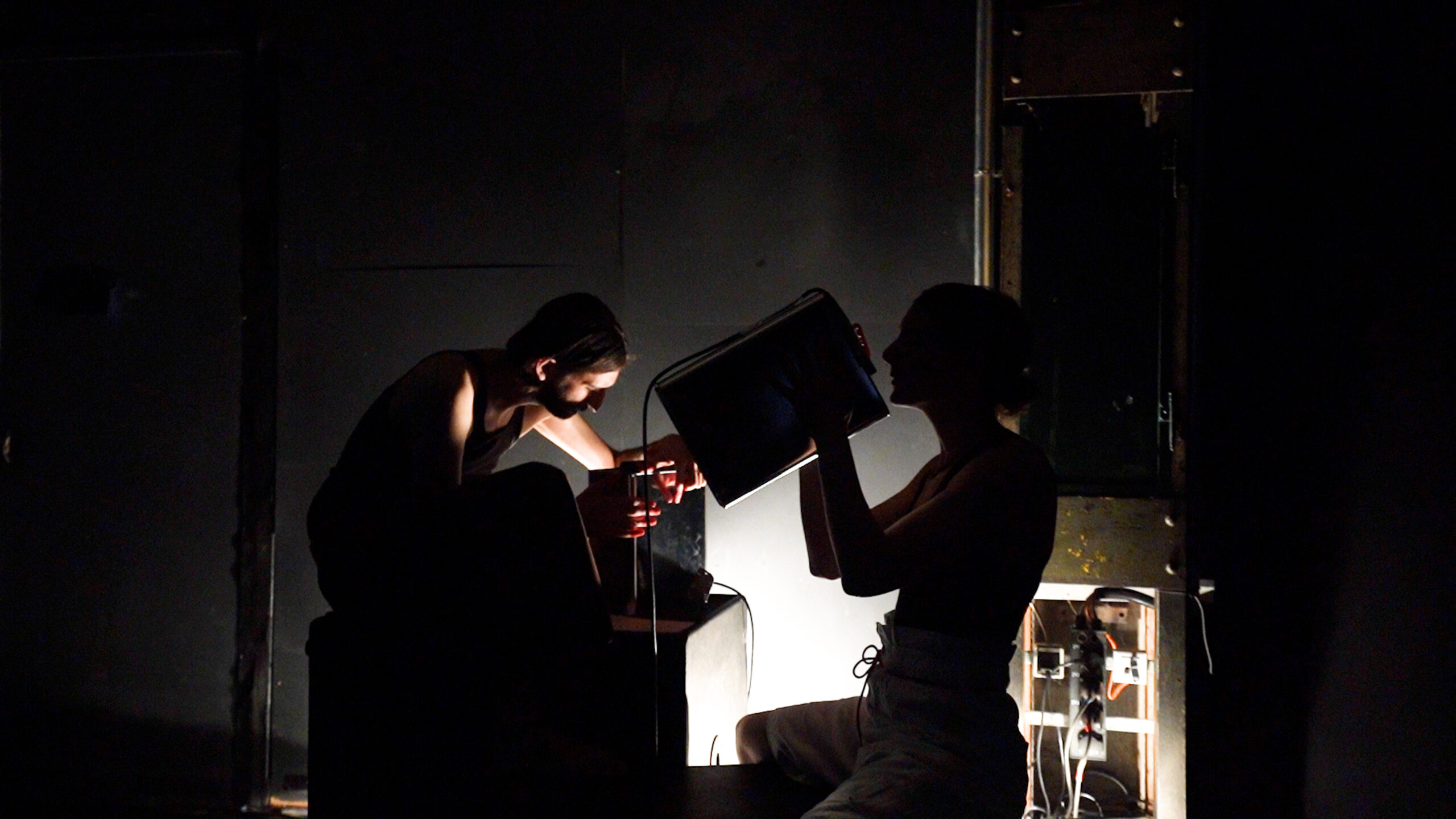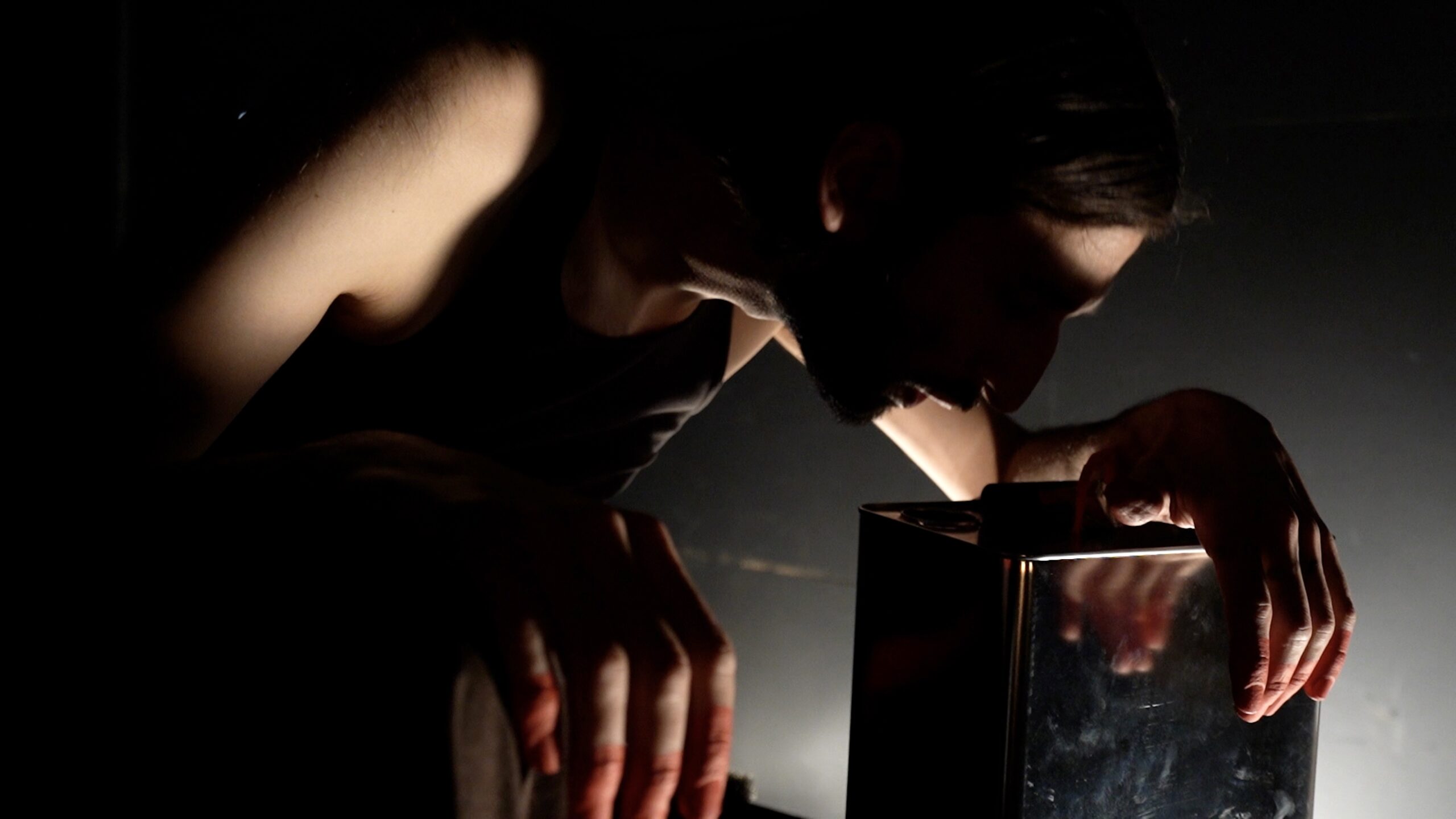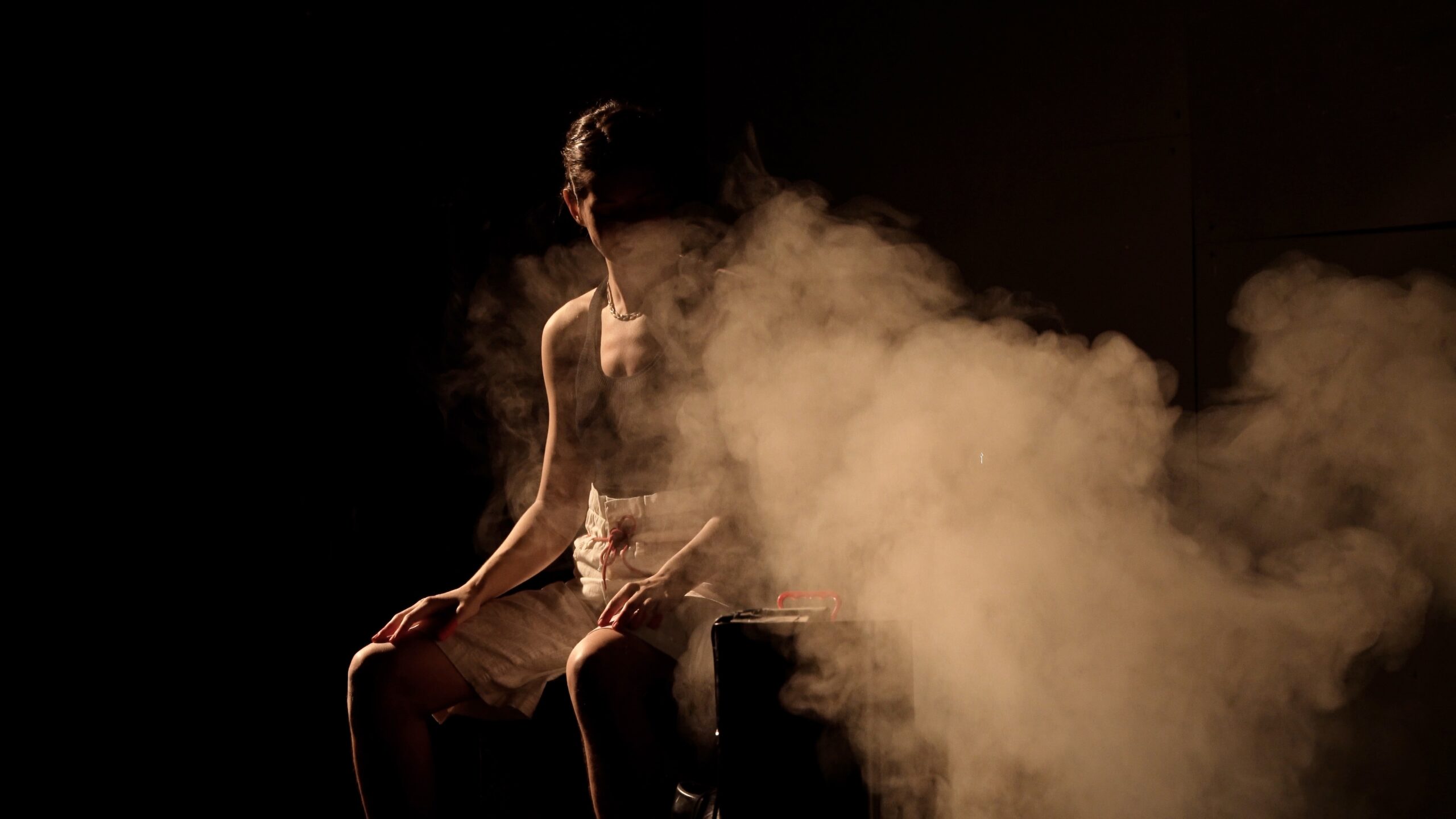The Mit Wirkung event series centres on solidarity in the fight against German racism, with a focus on anti-Muslim racism and anti-Semitism. With the unique performative research by artists Anna Lublina and Samuel Hatchwell [hoyah], the sixth and final event in Mit Wirkung is dedicated to the often missing, often erased aspects of Jewish identity, roots and shared histories that can be traced back to the Jewish-Muslim world.
Rhythm travels, Rhythm migrates, Rhythm adapts, Rhythm resists. Rhythm is a vibration that synchronizes your heartbeat to the heartbeat of another. In this performance, Rhythm is the character of Jewish diaspora, reaching back in time to shared Jewish-Muslim worlds: worlds that were not defined by borders, nationalisms, or divisions that emerged with the advent of colonialism. Artist Anna Lublina and musician hoyah work with tap dance, extended vocal techniques, and live mixing to ask what the political and cultural history of diasporic Jewish rhythm (and its embodiment) can teach us in a time marked by polarization and violence.
Anna Lublina and their team are all artists trying to flee the confines of nationalism in the spirit of Doykeit.
The performance will be followed by an audience talk.
The performance is part of »Mit Wirkung. Eine Relaxed Veranstaltungsreihe über intensive Themen«. On Apr 26+27 there will be further performances in the regular program.
A production by Anna Lublina in cooperation with Ballhaus Ost and Produkionhaus Naxos. Funded by Ottilie Roederstein Stipendium des Hessischen Ministeriums für Wissenschaft, Forschung, Kunst und Kultur; Kulturamt Frankfurt am Main; Kulturamt Gießen; Fonds Darstellende Künste mit Mitteln des Beauftragten der Bundesregierung für Kultur und Medien. Development supported by the LAB at English Theater Berlin and Ma’r’ayah Fellowship for Jewish and Muslim artists at Kunstlerhaus Bethanien.
- Apr 25, 2025
- Access / Content Note
-
in German, English, and Hebrew spoken language
accessible for wheelchair users
various seating options
relaxed performance
Accessibility Information
If you have any questions regarding accessibility, please contact Agnieszka Habraschka. Agnieszka will be present at the event as the Access Person and will assist you with any questions or requirements related to accessibility.
The event happens on the ground floor and is accessible without stairs.
The performance was retrospectively adapted as a relaxed performance.
General Information on Content and Sensory Cues
The Mit Wirkung events address German Racism, with focus on antisemitism and anti-Muslim racism in Germany.
Mit Wirkung VI centers on a performance exploring erased and missing aspects of Jewish identity, roots, and shared histories that trace back to a Jewish-Muslim world.
Food will be served during the event, with garlic as a central element, so there will be noticeable smells in the space.
Detailed information on content and sensory stimuli, as well as allergen information, can be found below.
Relaxed Event
The events take place in a relaxed atmosphere.
Various forms of attention are welcome. There will be different seating options, sensory toys*, blankets, drinks, and food (including gluten-free and vegan alternatives). You are free to move around, participate sitting or lying down, and use sensory toys*. You can take breaks independently and come and go as needed.
Seating Options
Chairs, bean bags, cushions, stools
Quiet Room
There is a quiet room with bean bags, lying options, blankets, and sensory toys*.
*Sensory toys are small, calming objects such as stress balls, putty, or fidget rings that particularly help neurodivergent people regulate their nervous system.
What is a Relaxed Event?
Relaxed events are based on the format of a Relaxed Performance and aim to provide accessibility, particularly for neurodivergent individuals, people with chronic illnesses/pain, and those with invisible disabilities. In these events, accessibility is not an afterthought but an integral part of the event concept. Just like in theater performances, there are often implicit behavioral expectations at events that make it difficult for neurodivergent people or those with chronic illnesses/pain to fully participate. Examples include expectations to sit still, move little, or not take breaks independently. These conventions can hinder participation for many people. The aim of the relaxed event format is to eliminate these rules/expectations.
Additionally, relaxed formats offer a sensitive approach, especially for emotionally charged or trauma-related topics. At the beginning of each event, we will share various body exercises with you, designed to calm the central nervous system, which you can perform individually or as a group.
Schedule
6:30 – 7:00 Soft Arrival
7:00 – 8:15 PERFORMANCE
8:20 – 8:40 Break
8:40 – 9:10 Food
9:10 – 9:40 Q&A
Content Notes / Sensory Stimuli / Allergens
the land speaks to me of something shared: a prayer for ancestral rhythms – Anna Lublina & Samuel Hatchwell (hoyah)
Performance in English, Hebrew, and Arabic
75 minutes
The performance explores rhythms that trace back to Jewish-Muslim worlds. It reflects on how the emergence of national ideology and sociopolitical development have affected rhythms and music. The performance is a mediation on often erased and overlooked aspects of Jewish identity, roots, and shared histories.
Content Notes:
-Extended and repeated slapping on bare skin (on one’s own and another’s chest)
-Physical contact between the performers
-Close proximity between performers and audience
-Dark stage atmosphere, including moments of complete darkness (blackouts)
-Rhythmic, repetitive movement and singing
-Potentially overwhelming sound density
-Poetry addressing themes of violence, origin, belonging, and transformation
-Narrative text dealing with displacement, colonialism, diaspora, cultural appropriation, and remembrance
-Spoken text is not always intelligible due to distortion
-References to historical traumas such as the Holocaust, the displacement of Jewish and Muslim communities, and colonization
-Discussion of the appropriation of Palestinian music in Israeli culture
-Critical reflection on nationhood, purity, identity, and collective history
Sensory Stimuli:
-Dark lighting with focused spotlights
-Light slapping on bare skin over extended periods
-Distorted voices using effects such as echo, reverb, and amplification
-Extended periods of loud rhythmic sounds (tap dancing, drumming on metal)
-Metallic banging and drumming on tin cans used as instruments
-Two full blackouts (complete darkness), approximately in the middle and at the end
-Subwoofer sound resembling a generator
-Sudden shifts between dense soundscapes and silence
-Strong visual contrasts (e.g. reflective metal surfaces lit from below)
-Slowly building layered vocal arrangements
-Overlapping of voices and sounds to the point of indistinguishability
- two scenes with use of hazer (one close to the beginning, the other closer to end)
-Smell of garlic
Food – Jasmina Al-Qaisi
The food will be prepared after the break as part of a ritual. It mainly consists of finger food and will be served on paper plates. There are no tables for participants to sit and eat.
Content Notes:
Audience may participate in crushing garlic
Sensory Stimuli:
Soundscape of conversations, many people speaking at the same time
Smell of food, especially garlic
Allergens
-Garlic
-Butter (contains lactose)
-white salty cheese (contains lactose)
-black kumin
-sesame
-leek
-Wheat and gluten
-Gluten-free alternative: potatoes
-May contain conservants
Q&A
This is an open conversation. Because it is an open format, exact content notes cannot be provided. Possible topics include:
Content Notes:
-Jewish/arabic identity
-Erasure under statehood
-Diversity in jewish identities
-Erasure under zionism
Spaces and WC
There is continuous, step-free and level access (incl. kerb ramp) from the street to the building and to the hall with a width of at least 150 cm. The floor surface in the courtyard is slightly uneven.
The event takes place in the hall, which is at ground level.
The hall is entered through a 194 cm wide double door. Then there is a second double door, which has an entrance dimension of 180 cm. The third double door, through which the audience enters the hall, is 136 cm wide.
There is no elevator.
Unfortunately, the bar can only be reached via a staircase on the second floor and is therefore not accessible for wheelchair users. There are 17 steps between the first floor and the second floor.
There is space for wheelchairs or walking frames in the event hall/area and there is the option of reserving a particularly suitable seat and/or entering the hall early.
Accessible WC
There is a wheelchair-accessible toilet on the first floor of the building. Access to this toilet is via the corridor and is 198 cm wide. The entrance to the toilet is 79 cm wide.
How to reach us
The nearest stop is U-Bahnhof Eberswalderstr.
The underground station has an elevator. The subway station is located at an intersection with a lot of car and pedestrian traffic.
From there, parts of the path to Ballhaus Ost lead over cobblestones.
The entrance to the theater is through the archway in the courtyard of the building at Pappelallee 15.
Parking
In Pappelallee there are parking spaces in the public area on the roadside. The theater cannot offer its own parking spaces.








